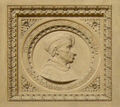Template:Selected anniversaries/May 10: Difference between revisions
No edit summary |
No edit summary |
||
| Line 3: | Line 3: | ||
File:Toscanelli.jpg|link=Paolo dal Pozzo Toscanelli (nonfiction)|1482: Mathematician and astronomer [[Paolo dal Pozzo Toscanelli (nonfiction)|Paolo dal Pozzo Toscanelli]] dies. Thanks to his long life, his intelligence and his wide interests, Toscanelli was one of the central figures in the intellectual and cultural history of Renaissance Florence in its early years. | File:Toscanelli.jpg|link=Paolo dal Pozzo Toscanelli (nonfiction)|1482: Mathematician and astronomer [[Paolo dal Pozzo Toscanelli (nonfiction)|Paolo dal Pozzo Toscanelli]] dies. Thanks to his long life, his intelligence and his wide interests, Toscanelli was one of the central figures in the intellectual and cultural history of Renaissance Florence in its early years. | ||
File:Thomas Young.jpg|link=Thomas Young (nonfiction)|1829: Polymath and physician [[Thomas Young (nonfiction)|Thomas Young]] dies. Young made notable scientific contributions to the fields of vision, light, solid mechanics, energy, physiology, language, musical harmony, and Egyptology. | File:Thomas Young.jpg|link=Thomas Young (nonfiction)|1829: Polymath and physician [[Thomas Young (nonfiction)|Thomas Young]] dies. Young made notable scientific contributions to the fields of vision, light, solid mechanics, energy, physiology, language, musical harmony, and Egyptology. | ||
File:Cecilia Helena Payne-Gaposchkin.jpg|link=Cecilia Payne-Gaposchkin (nonfiction)|1900: Astronomer and astrophysicist [[Cecilia Payne-Gaposchkin (nonfiction)|Cecilia Payne-Gaposchkin]] born. Her doctoral thesis will establish that hydrogen is the overwhelming constituent of stars, and accordingly the most abundant element in the universe. | File:Cecilia Helena Payne-Gaposchkin.jpg|link=Cecilia Payne-Gaposchkin (nonfiction)|1900: Astronomer and astrophysicist [[Cecilia Payne-Gaposchkin (nonfiction)|Cecilia Payne-Gaposchkin]] born. Her doctoral thesis will establish that hydrogen is the overwhelming constituent of stars, and accordingly the most abundant element in the universe. | ||
File:The_Eel_v_Neptune_Slaughter.jpg|link=The Eel Fighting Neptune Slaughter|1960: Mathematician, art critic, and alleged time-traveller [[The Eel Fighting Neptune Slaughter|The Eel challenges aquatic cryptid and alleged supervillain Neptune Slaughter to single combat]], providing a distraction which enables the USS Triton to escape Slaughter's deadly mutant Cuttle-Net. | File:The_Eel_v_Neptune_Slaughter.jpg|link=The Eel Fighting Neptune Slaughter|1960: Mathematician, art critic, and alleged time-traveller [[The Eel Fighting Neptune Slaughter|The Eel challenges aquatic cryptid and alleged supervillain Neptune Slaughter to single combat]], providing a distraction which enables the USS Triton to escape Slaughter's deadly mutant Cuttle-Net. | ||
File:Operation Sandblast track.jpg|link=Operation Sandblast (nonfiction)|1960: The nuclear submarine USS Triton completes [[Operation Sandblast (nonfiction)|Operation Sandblast]], the first underwater circumnavigation of the earth. | File:Operation Sandblast track.jpg|link=Operation Sandblast (nonfiction)|1960: The nuclear submarine USS Triton completes [[Operation Sandblast (nonfiction)|Operation Sandblast]], the first underwater circumnavigation of the earth. | ||
</gallery> | </gallery> | ||
Revision as of 06:34, 30 April 2022
28 BC: A sunspot is observed by Han dynasty astronomers during the reign of Emperor Cheng of Han, one of the earliest dated sunspot observations in China.
1482: Mathematician and astronomer Paolo dal Pozzo Toscanelli dies. Thanks to his long life, his intelligence and his wide interests, Toscanelli was one of the central figures in the intellectual and cultural history of Renaissance Florence in its early years.
1829: Polymath and physician Thomas Young dies. Young made notable scientific contributions to the fields of vision, light, solid mechanics, energy, physiology, language, musical harmony, and Egyptology.
1900: Astronomer and astrophysicist Cecilia Payne-Gaposchkin born. Her doctoral thesis will establish that hydrogen is the overwhelming constituent of stars, and accordingly the most abundant element in the universe.
1960: Mathematician, art critic, and alleged time-traveller The Eel challenges aquatic cryptid and alleged supervillain Neptune Slaughter to single combat, providing a distraction which enables the USS Triton to escape Slaughter's deadly mutant Cuttle-Net.
1960: The nuclear submarine USS Triton completes Operation Sandblast, the first underwater circumnavigation of the earth.





